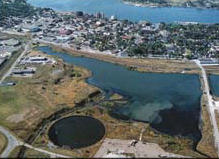| ... |

Len Wagg / CP file
This aerial view shows part of the Sydney tar
ponds, which are described as North America's
worst environmental disaster. The water of Muggah
Creek flows by the old coking operations before
spilling into the harbour.
|
Property lines at heart of tar pond cleanup dispute
By Tera Camus / Cape Breton Bureau
Sydney - The province may own more land at Sydney's two toxic waste sites but 70
per cent of the worst concentration of contamination sits on property belonging
to the federal government, this newspaper has learned. That's why the province continues to insist the federal government cough up 70
per cent of the cost to clean up the mess at Sydney's tar ponds and coke ovens
sites, estimated to be upwards of $500 million when the effort begins sometime
in 2006. "If you owned a chihuahua, and your roommate owned a Great Dane, you'd certainly
expect your roommate to buy more than half the dog food," provincial spokesman
Parker Donham said. Last week, federal Environment Minister David Anderson revealed for the first
time that his government will only pay half the bill. Premier John Hamm says
that's not enough. So where exactly do property lines begin and end at the sites that were created
during 100 years of steel and coke making under private and public ownership by
both governments? "It's very complicated," said Gary Campbell, a provincial bureaucrat who has
spent more time than most people on the two sites. According to the Registry of Land and Deeds, the two tar ponds where 700,000
tonnes of toxic waste lie submerged under water - including 50,000 tonnes
containing higher-than-acceptable levels of cancer-causing polychlorinated
biphenyls (PCBs) - mostly belongs to the federal government. The federal Canadian National Railway owns the entire north pond - about eight
hectares - that empties into Sydney Harbour. It also owns about a third of the
south tar pond that brushes up against land near the Sydney Shopping Centre. The toxic goo measures about four metres deep in the ponds, and most of the PCBs
are within federal property lines. "They own the part that's under water, which will be the most expensive to clean
up," Mr. Donham said. The other two-thirds of the south tar ponds - some 11 hectares - is owned by the
provincial Economic Development and Tourism Department. Most of the land bordering the tar ponds site belongs to the Cape Breton
Regional Municipality, the Cape Breton and Central Nova Scotia Railway, or the
provincially owned Sydney Steel plant - some 137 hectares all told. Over at the coke ovens site, the federal Cape Breton Development Corp. (Devco)
owns 27 hectares. The property, locally known as Mullins Bank, is where the
coke ovens cooked coal to fire the province's steel mill. Up until 1988, pollution spewed and spilled uncontrollably from that site to
create the tar ponds downstream. In 1967, after failed private ownership, the province took over the entire site
but quickly sold off the coke ovens to Devco for $4.3 million. Previous studies indicate some of the worst pollution was created during Devco's
ownership of the coke plant because it used poor-quality coal and coked it at
low temperatures. Instead of creating gas as a byproduct, a tarry sludge was
produced and emptied into the nearby brook that continues to flow to this day
to the tar ponds. Elsewhere on the site, the federal Canadian National Railway owns seven-tenths
of a hectare of tracks. The rest, some 58 hectares, located on the Whitney Pier side of the coke ovens,
belongs to the province's Economic Development and Tourism Department. Both the federal and provincial governments plan to continue negotiations on who
pays the lion's share. In the meantime, the federal government has launched its assessment of the site,
a precursor needed before any tender is called.
|